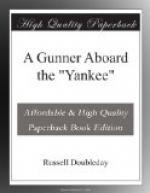“No, no; none of those things,” said he. “What do you suppose we have been doing for the last twenty minutes?”
We confessed we did not know.
“Chasing thunder claps—nothing more nor less than thunder claps! And we’ll see nothing worse on this coast,” he added sententiously, as soon as he could get his breath.
The wind rose, and while it blew away the fog in part, it kicked up a nasty sea, in which the “Yankee” wallowed for hours, waiting for the fog to clear enough to make the channel and enter New York harbor. It seemed we had been heading for New York, and we did not know it. It was not the custom aboard that hooker to give the men any information.
[Illustration: “The ‘Yankee’ dropped her anchor off Tompkinsville”]
When we learned for sure that we were bound for New York, our joy was beyond measure.
Shore leave was the chief topic of conversation. And every man not on duty went down into his black bag, fished out his clean blues, and set to work sewing on watch marks and cap ribbons. For Jack must be neat and clean when he goes ashore.
The mud-hook was dropped in the bay off Tompkinsville, Thursday, May 26th, seventeen days after we left the navy yard. It seemed seventeen months.
An “anchor watch” of sixteen men was set for the night, and most of us turned in early to enjoy the first good sleep for many weary days.
All hands were turned out at five o’clock. We woke to find a big coal barge on either side of the ship.
After breakfast the order “turn to” was given. “All hands coal ship, starboard watch on the starboard lighter, port watch on the port lighter.” From seven o’clock in the morning till twelve o’clock that night, the crew of the “Yankee”—aforetime lawyers, physicians, literary men, brokers, merchants, students, and clerks—men who had never done any harder work than play football, or row in a shell—coaled ship without any rest, other than the three half hours at meal times. About the hardest, dirtiest work a man could do.
The navy style of coaling is different from that customary in the merchant service. In the latter, the dirty work is done in the quickest, easiest way possible. The ship is taken to a coal wharf and the coal is slid down in chutes, or barges are run alongside and great buckets, hoisted by steam, swing the black lumps into the hold or bunker.
The navy style, as practised on the “Yankee,” was quite different. The barges were brought alongside, the men divided into gangs—some to go in the hold of the barge, some to go on the platforms, some to carry on the ship herself. The barge gang shovelled the coal into bushel baskets; these were carried to the men on the stages; and the latter passed them from one to the other, to the gun deck; finally, the gang on the vessel carried the baskets to the bunker holes, and dumped them. The ship was well provided with hoisting machines, but, for some reason, this help was not permitted us.




